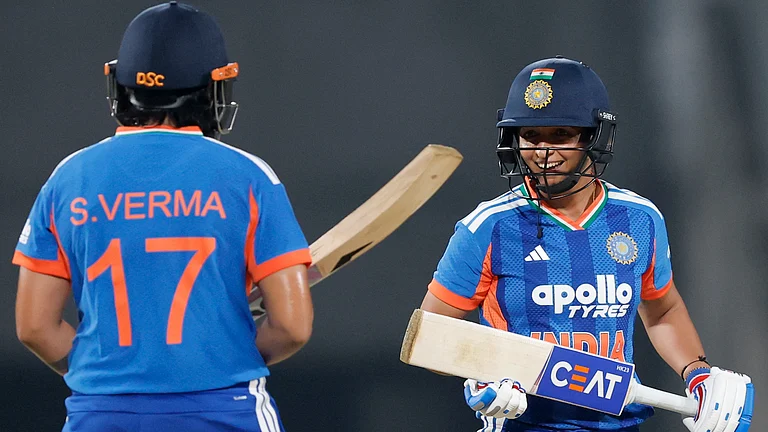The EU and South Asia may well be compared to Goliath and David except that fortunately they are not pitting their strengths against each other and this happens to be a 21st century forum to discuss growth for everyone.
To study whether the EU can be a role model for South Asia it may be well to first observe the differences and similarities of the two regions against a backdrop of studies on regional and multilateral trade. In its current avatar, the South Asian Free Trade Agreement (SAFTA) is a mere fledgling in the face of the two gigantic trade blocs in the making--the Enlarged European Union (EEU), the Free Trade Area of the Americas (FTAA) and the third possible East Asian Free Trade Agreement (EAFTA). SAFTA cannot compare with the EU in its historical advantage, its wealth or its experience.
It was in 1952 that six European countries established the European Coal and Steel Community. They pooled their resources in a common market that was controlled by an independent supranational authority. In 1958 this was extended to all economic sectors and by 1986 there were 12 countries in the Union. By 1993, the now 15-member union admitted 10 more "accessioncountries" [1]. The common currency, Euro was launched completely by January 1, 2002. The dream of the founding fathers was that the EU would make Europe whole and free. The desire to enlarge is underlined by the aim to reach a scale of economic activity that could even challenge the supremacy of the US in world trade.
In comparison, South Asia can hardly talk of free trade when its members have yet to follow the process of market integration even within their markets. As things stand today, say in a country like India every state has enormous autonomy over trade matters right from taxes to procedures. These barriers must first go. Free trade between nations is a great idea but things like fiscal and monetary co-ordination are very far off where South Asia is concerned. Members have to first streamline their internaltrade. [2]
Next, India’s unilaterally signed agreements with neighbours Sri Lanka and Bangladesh leave a lot to be desired. The perception of benefit in those countries should be strong but it isn’t. Dr SubirGokarn [2] relates of a recent visit to Sri Lanka where the feel good factor was conspicuous by its absence. For instance, the Sri Lankans have looked forward to open Indian markets for their goods. But that has yet to happen. High non-tariff barriers like customs have so far marred the process. Exporters complain of shipment getting stuck for months while the Indian customs officials decide on what levies apply. Others complain about corruption and lobbying. A Sri Lankan tea exporter had his consignment berthed at the Chennai port for six months and then returned. The opportunities that were expected have not been utilized in these three years since the agreement was signed.
In the cases of the other major neighbors of India, Pakistan and China, the geo politics will definitely dictate. There have been random murmurs in India and Pakistan about segregating trade from politics but there is little economic exchange beyond Indian films, mostly pirated. With China, border disputes ruled the year long talks. The visiting Chinesepremier, Wen Jiabao commented on how the two countries could successfully associate in the IT business with China and India being extremely competitive in hardware manufacture and software products and services respectively. However a preferential agreement may be far off. The trade volumes are way below the requirement and it may take ten years to get there. So the kind of trade arrangement, the growth and the wealth of the EU would be a dream for the developing South Asian nations and appear just as far-fetched as dreams can be. India would most certainly have to take the lead being the most successful democracy in the region but it will first have to settle its internal issues.
Yet, some people like Rajesh Chadha and Devender Pratap [3] believe that such a scenario may well be possible. However, to understand what they propose let us first understand that the EU itself has certain drawbacks that may be severely limiting for the developing nations of South Asia. Apart from the creation of the EU, the European Community (EC) has continuously created many layers of Preferential Trade Agreement (PTAs) with developing countries. It has recently started entering into Free Trade Agreements (FTAs) with far away countries like Chile and Mexico and South Africa. There are, according to economists, several different layers of EC integration. It is then very difficult to analyze and compute the benefits of such complex arrangements made by the EC on developing countries. Also, the impact of enlargement is not yet visible.
The poorer accession countries joining in have no guarantee of catch-up growth. The stakes in the process then seem high and benefits uncertain. Studies that examine the empirical evidence to evaluate the gains from trade for participating countries conclude that the evidence for increased growth rates of the EU countries is weak. It also finds that benefits in the form of higher growth rates accrue first to the large countries and then to some smallercountries.[4]
Asia at large is already describing the same pattern. The number of PTAs in Asia is growing. The Association of South-East Asian Nations (ASEAN) and the South Asian Association for Regional Co-operation (SAARC) have both formed the AFTA and the SAPTA respectively. The Closer Economic Relations between Australia and New Zealand has deepened. Economists warn that such multi-layered regionalism that abounds in the Americas and Europe can camouflage a meaningful analysis at least by developing countries and the developed countries could turn out to be net gainers at theircost. [5]
Taking a leaf from the EU, should there be an Asian bloc beyond just South Asia and encompassing all of Asia? In recent times there have proposals towards larger co-operation. One such proposal suggested an ASEAN +3 (China, Japan, South Korea) + SAARC+ ESCAP (Economic and Social Council for Asia and the Pacific) scenario. Another proposed an RTA, JACIK (Japan, ASEAN, China, India, Korea).
The former is seen as a combination that could deliver on leadership in the Asian region that would in turn complement multilateralism but there is the concern of political motivation that could be counter productive. The latter speaks of enhancing global welfare but is non committal on whether this "welfare" stems from the growth of the participating countries or does it ensure welfare of the other countries of the region that may not bemembers [3]
What happens to the fate of the small countries within the FTAA, EEU, JACIK, ASEAN + 3 +SAARC + ESCAP? Do they really know whether to join the process of such "dinosauric blocalisation" or not? Do they actually understand enigmatic issue relating to the forthcoming Grand Agreements along with the issue relating to their existing liberalization commitments within the WTO? Can they afford the pecuniary costs involved? Do they have the requisite resources? Are the bilateral donors not going to maneuver the "capacity building exercise" in their own interest or else not build capacity? Would the regional initiatives, both bilateral and purilateral, not put pressure on whatever little intellectual capacity the small countries have away from multilateralism? These are the questions the duoasks.[3]
Against the backdrop of these concerns they believe that the relatively smaller sub-region of South Asia can actually provide a lead to resolve the multilateralism versus regionalism dilemma. Their solution: open regionalism. This, they believe can successfully withstand the existence of what they call the "dinosauric blocs".
The two economists have done a computational analysis of available data to prove that a very successful model is possible in the Asian region that learns from regional arrangements such as the EU but opts for a modification. They have proposed a radical model that could get brickbats but may eventually gather momentum as it moves from one important ear to another.
They call their new bloc the OP_EUFTAA or the Open Economic Unification through the Free Trade Agreement of Asia. They choose 23 Asian countries in the computational exercise while others are free to join. The difference from the existing Big Two: The bloc would be openly benign in its trade relations with every other country/ region including the Big Two or another RTAs or even countries that don’t belong to any RTA.
The computational analysis relies on the data from the GTAP-5 Database of the Purdue University Centre for Global Trade Analysis Project that provides a picture of the world in 1997 when the ASEAN, SAARC, NAFTA and EU were in operation as preferential trading blocs. It simulates the economic effects of reduction of tariff barriers on trade across member countries. The study involves the four major SAARC members- India, Bangladesh, Pakistan and Sri Lanka and nine other countries/ regions namely China, ASEAN, NIEs, Japan, ANZ, NAFTA, EU, South America and "others" (all countries that do not belong to any of the earlier groups).
The first simulation is in two parts: the first with regional liberalization where trade barriers are maintained with countries outside the group and the second of open liberalization where the four countries eliminate import barriers from member countries as well as unilaterally for all other countries/ regions. Each simulation adds one more country/ region under the same two options.
The results may be interesting to note. In 1A, all the four countries benefit in welfare by 0.2 per cent to 2 per cent. They gain $2.3 billion in welfare in 1A (preferential liberalization) as also does the rest of the world. But this "world" gain accrues to the members of NAFTA and the EU only while others lose. In 1B (open regionalism) South Asia gains three times while global gains are nearly ten times as much. All regions and countries show larger gains.
As more countries are added in every successive simulation two things stand proven: 1) that as more regions of Asia join the bloc the gains for everyone involved are more and 2) the gains in the open regionalism are larger for everyone than in preferential regionalism. In the final scenario that includes all 23 Asian countries from different blocs, the South Asian countries gain $8.2 billion and the global gains are dramatically high at $ 289 billion against $7.1 billion and $113 billion respectively in the PL format. In fact in a case like Bangladesh only the open regional format brings it any welfare gains. In the other it actually stands to lose.
This may be probably the most favorable option for the developing countries of South Asia until that perfect, utopian time in the future when there is really free global trade. So while they continue to be a part of regional blocs for more reasons than trade perhaps, this system could give them a lot of the benefits of perfect, multilateral trade.
A pertinent, local example [6] can explain how trade between non bloc partners can only benefit both as well as hurt no one else. Take for example the pharmaceutical industry that has been so much in the news of late. India has immense potential in terms of high technological skills and production capacities that have MHRA and US-FDA approval. This could be the perfect place for the EU to shop when looking for cheaper generics to reduce the burgeoning healthcare and social security costs. This extra-bloc trade wouldn’t adversely affect India’s trade with its South Asian partners as manufacturers would clearly demarcate capacities for different markets. All its partners would benefit from its inexpensive drugs while India would gain a substantial trading volume.
So while South Asia can look at the EU to learn the lessons of simplifying internal trade, co-operation, patience and focus it may be better off looking at trade associations that lean towards multilateralism. Multilateralism seems to be the way for positive impact on economic welfare and real returns to labour and capital in both the industrialized and developing countries. Of course in practice other, often non-trade realities will exist and influence decisions and final associations. But this may be the path to find the answers to South Asia’s developmental blueprint.
References and Footnotes
1. The 10 countries: Cyprus, Malta, Czech Rep.,Slovakia, Hungary, Poland, Estonia, Latvia, Lithuania, Slovenia. Turkey follows. Bulgaria and Romania could join by 2007.
2. Interview with Dr Subir Gokarn, executive director and chief economist, CRISIL
.
3. Research paper by Rajesh Chadha, chief economist, The National Council of Applied Economic Research, (NCAER) New Delhi and colleague, DevenderPratap, The Dinosauric Blocalisation versus the Multilateral Liberalisation: Can the Lilliputan South Asian Free Trade Agreement Make a Difference?
4. Europe Enlarged: Understanding the Impact – Report by the Economist Intelligence Unit
5. The Asian Development Outlook 2002 as quoted in the Chadha and Pratap report.
6. Suresh Kare, president, Indian Drug Manufacturers’ Association (IDMA) in a written comment on the EU India Trade Relations in the pharmaceutical industry.

























